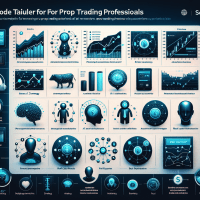Solvent.Life vs Vantir: AI Trading Models Compared
In the fast-paced world of prop trading, leveraging AI strategies and feedback models is crucial for staying ahead of the competition. In this article, we dissect the advanced nuances between Solvent.Life and Vantir and explore how their respective AI approaches – strategy-driven versus feedback model– can empower traders to optimize backtesting, improve risk management, and unlock actionable trading insights.
Understanding the Landscape: AI in Prop Trading
Prop trading firms are continuously integrating automated solutions to improve strategy development and decision-making speed. With the advent of AI, traders now have sophisticated tools that can backtest complex strategies, perform walk-forward optimization, and provide real-time feedback. The two leading platforms, Solvent.Life and Vantir, are at the forefront of this evolution. While Solvent.Life focuses on a robust AI strategy framework, Vantir emphasizes AI feedback models, each offering unique benefits and challenges.

Figure 1: Solvent.Life interface showcasing an AI-driven strategy development module used in prop trading.
Advanced Backtesting: Pitfalls and Best Practices
When developing prop trading strategies, one of the critical aspects is backtesting. Advanced backtesting involves simulating trading strategies using historical data to understand potential risks and rewards. However, the process comes with inherent pitfalls:
- Overfitting: Excessively tailoring a strategy to historical data can lead to poor performance in live markets.
- Survivorship Bias: When historical data only includes successful entities, resulting in misleading performance results.
- Look-Ahead Bias: Using future information in backtesting that would not have been available at the time of the trade.
- Data Snooping: Repeatedly testing multiple hypotheses on the same dataset can create false positives.
To mitigate these issues, traders should integrate walk-forward optimization techniques and ensure rigorous out-of-sample testing before transitioning to live markets. This balanced approach is essential both for prop firms and individual retail traders alike.
Walk-Forward Optimization vs. Traditional Backtesting
Unlike traditional backtesting, which relies solely on historical data, walk-forward optimization repeatedly tests strategies over multiple time segments. This method not only provides a more realistic simulation of market conditions but also helps in identifying robust strategies that withstand changing market dynamics. For example, a prop trading firm might run a 12-month walk-forward analysis to iteratively adjust parameters based on market cycles, ensuring their strategy remains resilient despite volatility.
Case Studies: Real-World Applications in Prop Trading
Consider the case of a mid-sized prop trading firm that sought to improve its algorithmic trading framework. Initially, the firm encountered challenges in accurately predicting market trends due to overfitting and data biases. By integrating Solvent.Life’s AI strategy module, they managed to implement a comprehensive backtesting system that included:
- Automated parameter optimization which reduced overfitting by dynamically adjusting strategy variables.
- Sophisticated report generation that highlighted potential pitfalls clearly, like drawdown metrics and Sharpe ratio fluctuations.
- Stress testing scenarios that prepared the team for market stress events.
The result was a quantifiable improvement in their portfolio’s Sharpe ratio by 0.35 points and a noticeable reduction in maximum drawdown. In contrast, another firm using Vantir’s AI feedback models benefited from real-time insights to adjust positions on-the-fly, tailoring responses to both sudden market shifts and prolonged trends.
Comparative Analysis of AI Trading Tools
Below is an in-depth comparison of two widely recognized trading platforms that prop firms and individual traders often use:
| Feature | TradingView | NinjaTrader | QuantConnect |
|---|---|---|---|
| Backtesting Method | Event-driven with vectorized execution; supports commission and slippage modeling. | Primarily vectorized, offers optimization and scenario analysis. | Supports both event-driven and vectorized backtesting with automated parameter optimization. |
| Data Quality | Reliable across multiple asset classes with deep historical data. | Strong historical and real-time data feeds predominantly for futures and forex. | Extensive historical dataset covering equities, forex, and cryptocurrencies. |
| Integration | API integration for broker connectivity and analytics platforms. | Seamless integration with multiple brokers and third-party analytics tools. | Robust API access and community-driven integrations. |
| Pricing | Free basic version with premium features at competitive monthly rates. | Free demo with tiered pricing for professional use. | Free tier available; scalable pricing based on usage and data needs. |
| Use Cases | Best for retail traders needing accessible, visual strategy tools. | Geared towards both retail and firm-level trading requiring detailed charting. | Ideal for prop firms and quants requiring extensive data and algorithmic flexibility. |
This comparison highlights how each tool can serve different trading needs. For instance, TradingView is perfect for quick strategy visualization, whereas NinjaTrader and QuantConnect offer in-depth algorithmic analysis suited for both team collaboration in prop firms and individual traders.
Implementing Automated Backtesting: A Step-by-Step Guide
To integrate automated backtesting into your trading workflow, follow these steps:
- Define Clear Objectives: Determine the key metrics you want to optimize (e.g., Sharpe ratio, maximum drawdown, win/loss ratio).
- Gather High-Quality Data: Utilize reliable data sources such as tick data with proper adjustments for corporate actions and market events.
- Choose the Right Tools: Select platforms like TradingView, NinjaTrader, or QuantConnect that best meet your strategy’s requirements.
- Configure Your Backtesting Environment: Set parameters for commission, slippage, and optimize using walk-forward analysis to simulate real market conditions.
- Analyze Results: Use automated report generation to highlight performance metrics and identify potential improvements.
Below is an example code snippet for a basic backtesting strategy using the Python Backtrader library:
import backtrader as bt
class TestStrategy(bt.Strategy):
def __init__(self):
self.sma = bt.indicators.SimpleMovingAverage(self.data.close, period=15)
def next(self):
if self.data.close[0] > self.sma[0]:
self.buy()
elif self.data.close[0] < self.sma[0]:
self.sell()
if __name__ == '__main__':
cerebro = bt.Cerebro()
cerebro.addstrategy(TestStrategy)
data = bt.feeds.YahooFinanceData(dataname='AAPL', fromdate=datetime(2020, 1, 1), todate=datetime(2021, 1, 1))
cerebro.adddata(data)
cerebro.run()
cerebro.plot()
Integrating Forward Testing with Live Markets
While robust backtesting is critical, it must be paired with forward testing before deployment in live accounts. Forward testing, often executed via paper trading, allows teams to assess performance against real-time market conditions. Monitor key performance indicators, and ensure real-world stress scenarios are replicated in a controlled environment. This integration is paramount for both junior traders and seasoned quants to confidently optimize their strategies.

Figure 2: A detailed backtesting report showcasing key performance metrics such as drawdown and Sharpe ratios, comparable across AI trading tools.
Expert Guidance and Industry Insights
As of October 2023, advanced prop trading strategies now incorporate both AI-driven backtesting and real-time feedback loops. Pro traders are advised to:
- Regularly recalibrate models to avoid overfitting.
- Adopt a dual approach that combines deep historical analysis with real-time adjustments.
- Utilize robust platforms that offer both automated backtesting and walk-forward analysis.
For example, firms leveraging Solvent.Life have seen marked improvements in stress testing capabilities, while those using Vantir’s AI feedback models frequently adjust trading positions intra-day based on market signals. This balanced approach caters to various roles within prop trading, from risk managers to individual traders seeking the edge in dynamic market conditions.
Regulatory and Compliance Considerations
Prop trading firms must always align with relevant regulatory frameworks. In Europe, MiFID II and ESMA regulations have raised the bar for transparency and risk management. In the US, NFA rules mandate careful oversight of algorithmic strategies. Ensuring compliance involves not only rigorous backtesting but also regular audits and documentation of all trading algorithms.
Next Steps for Enhancing Your Prop Trading Strategy
To further refine your prop trading strategy, consider downloading our comprehensive Risk Management Checklist, which outlines key metrics and regulatory guidelines tailored specifically for prop trading. Additionally, explore our internal resource on Advanced Prop Trading Strategies and Risk Management Tools for Prop Trading for deeper insights.
Implement these best practices and advanced techniques to elevate your trading performance and ensure robust, compliant, and profitable strategies.
Conclusion
Whether you are a junior trader seeking to gain foundational skills or a seasoned quant looking to refine your algorithmic strategies, understanding the nuanced differences between Solvent.Life and Vantir is essential. With thorough backtesting, the integration of walk-forward analysis, and a keen eye on compliance, prop trading can be transformed into a structured, disciplined, and profitable endeavor. Embrace these advanced methodologies and take your trading to the next level.
Pro Tip: Always monitor key performance metrics such as the Sharpe ratio, profit factor, and maximum drawdown to ensure your strategies remain resilient in volatile markets.
For ongoing expert insights, subscribe to our newsletter and join our upcoming webinar where we explore live case studies and emerging trends in prop trading technology.







